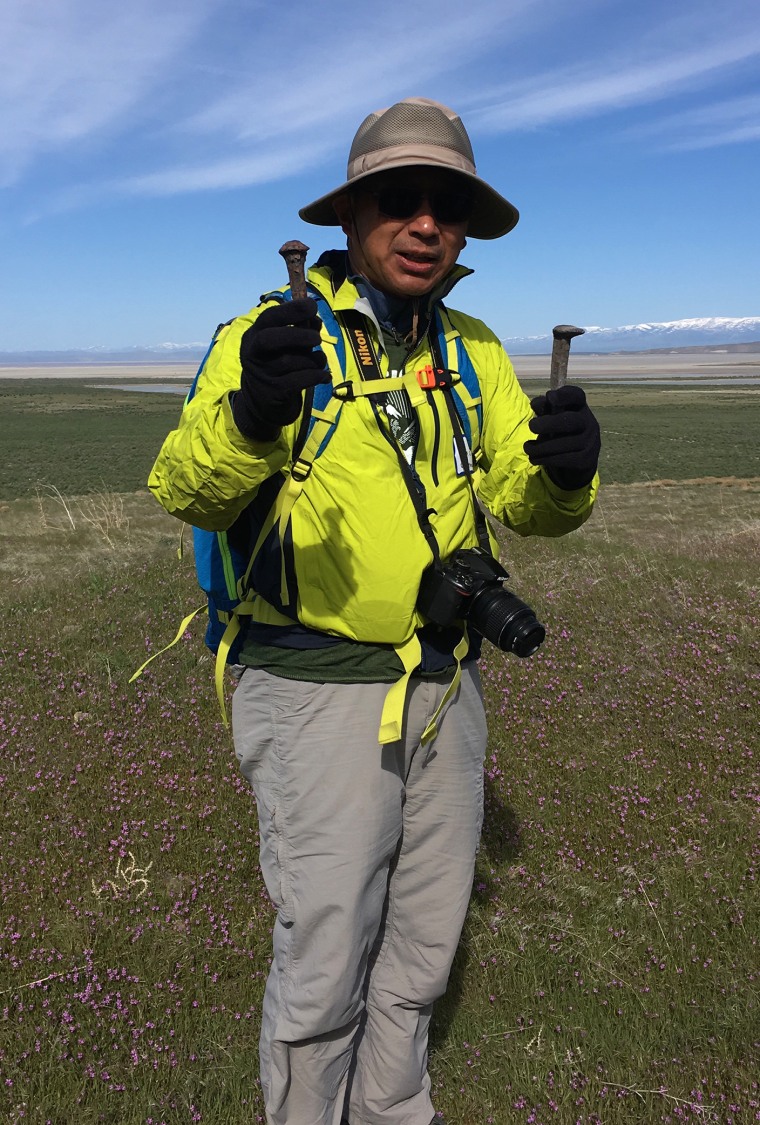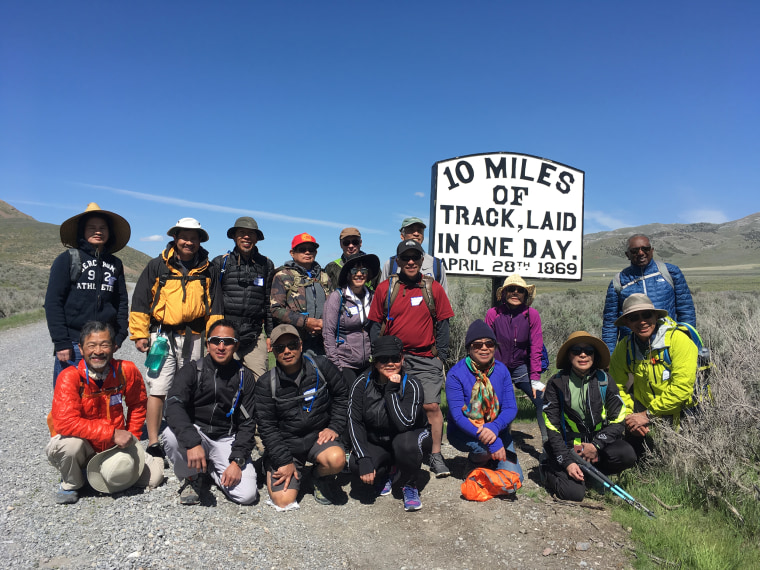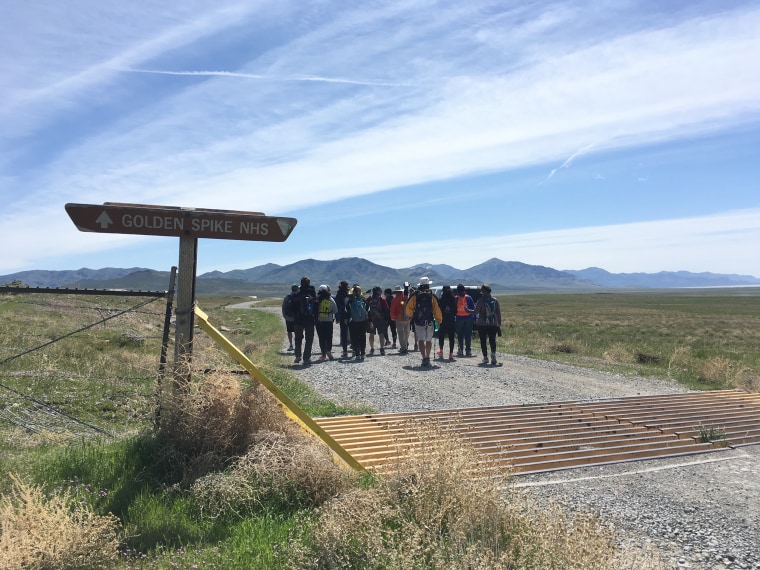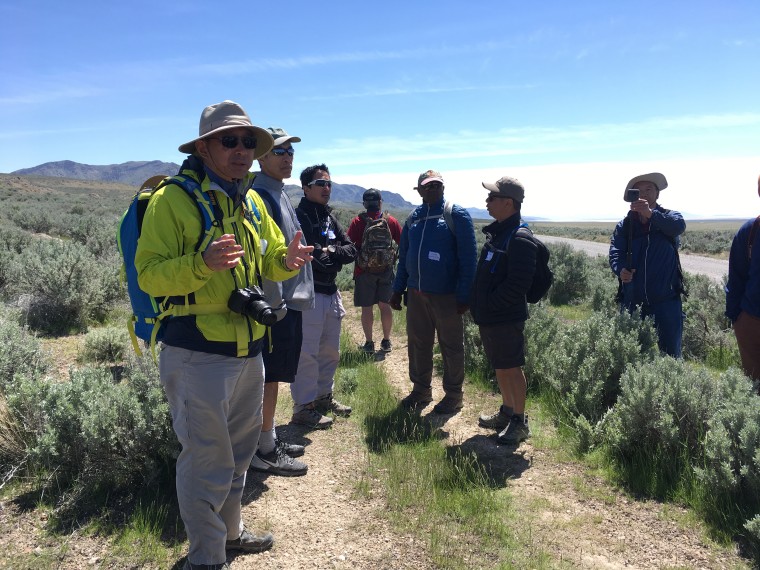PROMONTORY, Utah — For most people, birthday celebrations are a time to relax; for Jack Shu’s 67th birthday, he decided he wanted to go on a 10-mile hike in northern Utah.
It was an idea Shu, a retired California Department of Parks and Recreation employee, came up with when he learned that a momentous historical occasion coincided with his birthday this year: On April 28, 1869, a team of Irish and Chinese immigrant workers laid down a record-breaking 10 miles and 56 feet of railroad track on America's first transcontinental railroad, which connected the country from east to west.
“Because that day was my birthday, my main thought was, 'Gee what an interesting coincidence. This must be a sign that I should do something about this event,’” Shu said about the 150th anniversary of the track work.
Two companies — the Central Pacific Railroad Company and the Union Pacific Railroad — were tasked with the construction of the first transcontinental railroad. The project was a competitive one, as both companies were compensated for every mile of track they built.
In the race to build the railroad, the founder of the Central Pacific — whose labor force was almost 90 percent Chinese by 1867 — claimed his men could lay down 10 miles of track in one day to beat Union Pacific's record at the time of seven-and-a-half miles.
And so they did. On April 28, 1869, Central Pacific workers accomplished that feat in about 12 hours, and just 12 days before the railroad was completed.
150 years later, Shu drove to Utah from California to meet about two dozen people, including several retirees, who would join him on his hike.
The group first met at the trailhead in Promontory on April 28, 2019, at 9 a.m. and were greeted with temperatures in the high 40s and gusts of wind that kicked up the dirt on the path ahead. The plan was to hike 10 miles along the path of track that was laid down 150 years ago.

While a major portion of the first transcontinental railroad is no longer in use, remains of the track are still visible in some areas. Within the first mile of the hike, one man spotted a rusty spike embedded in the ground. Paul Lee, a retiree from California who co-organized the hike, said it's uncertain if the spike was an original one from 150 years ago, as the railroad was rebuilt and repaired after its completion.
The trail was virtually flat the entire way for a generally smooth trek, though hikers had to climb over gates on several occasions to continue forward. The area also had no restrooms, and wind was a constant element throughout the day. Despite that, the group overall appeared to enjoy the experience and spent much of the day talking as they walked.
A change in pace came about eight miles into the hike when Shu challenged them to walk for a mile in silence to reflect on what conditions and situations must have been like for the Chinese railroad workers: Did they think about their family? Were their muscles aching? Was it dusty while they worked?
Faye Mitsunaga, 55, a resident of Salt Lake City, said that moment of reflection prompted her to imagine how difficult the labor must have been. Workers who laid the 10 miles of track that day had to position thousands of materials totaling more than 4.4 million pounds, according to a 1928 article in the Southern Pacific Bulletin.
“This was hard,” Mitsunaga said during the last mile of the hike. “Even my legs are hurting now, my knees are hurting, but I can’t imagine them carrying things and working.”

The group ended the 10-mile hike a little after 3 p.m. at a replica of the sign marking the end of the record-breaking stretch of railroad built in 1869. Michael Kwan, president of the Chinese Railroad Workers Descendants Association, met them shortly after.
“It’s humbling to see how much people care about the accomplishment that the Chinese and the Irish did here, setting a world record that stands to this day,” said Kwan, whose great-great-grandfather worked on the railroad. “That they would take the time out to come out in the relatively cold weather to hike 10 miles is just an incredible feat.”
Several hikers said they weren't previously aware of the significance of the first transcontinental railroad or that Chinese immigrants helped build it.
It's become a source of pride for the Asian Americans who learned about it and participated in the hike.
“It makes me proud that the Chinese have the capabilities of doing so much. More than just Chinese restaurants and laundries,” said Tennyson Kwok, 70, a retired engineer from San Francisco. “We all know they built the Great Wall, but I think that now that the history of the Chinese helping build the railroad is elevating the Chinese to Americans, which didn't exist 150 years ago.”

John Jackson, 73, a former park ranger at Yosemite National Park and the oldest participant at Shu's birthday event, said the hike helped in fulfilling a larger understanding and meaning of the contributions various people have made to the country.
“And then your body kind of merges with that history and you take it with you and you’ll share it with others,” he said. “And hopefully, even more people will be interested in this kind of activity, because it’s not a video and it’s not a couch activity — it’s a physical activity.”
Shu said he hopes his 67th birthday hike will bring more attention to the people who built the railroad, particularly the 10 miles of track.
“We want to move that bar just a little bit towards the story of workers and not so much the companies that performed this job of getting more money from the government to complete the transcontinental railroad,” he said.
And it isn’t just the railroad workers Shu hopes his hike can highlight.
“The completion of the transcontinental railroad, this huge project at that time, was essentially done by immigrant workers. And there’s so many projects, so many things in the building of this country that were performed by immigrant workers and continues to be that way,” he said.
Follow NBC Asian America on Facebook, Twitter, Instagram and Tumblr.

